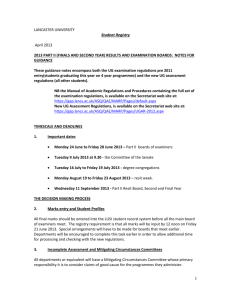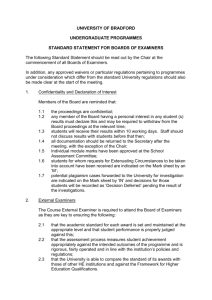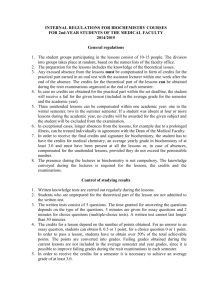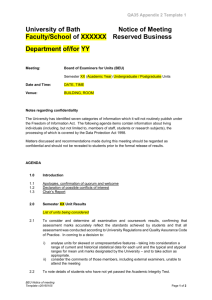Student Registry - Lancaster University
advertisement
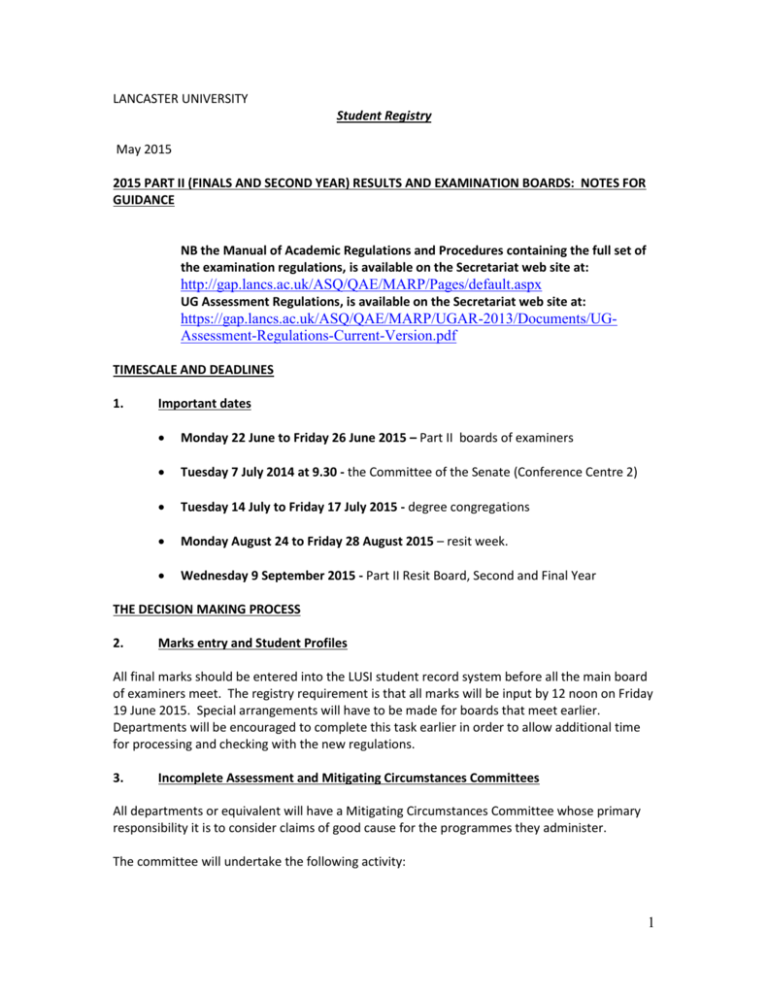
LANCASTER UNIVERSITY Student Registry May 2015 2015 PART II (FINALS AND SECOND YEAR) RESULTS AND EXAMINATION BOARDS: NOTES FOR GUIDANCE NB the Manual of Academic Regulations and Procedures containing the full set of the examination regulations, is available on the Secretariat web site at: http://gap.lancs.ac.uk/ASQ/QAE/MARP/Pages/default.aspx UG Assessment Regulations, is available on the Secretariat web site at: https://gap.lancs.ac.uk/ASQ/QAE/MARP/UGAR-2013/Documents/UGAssessment-Regulations-Current-Version.pdf TIMESCALE AND DEADLINES 1. Important dates Monday 22 June to Friday 26 June 2015 – Part II boards of examiners Tuesday 7 July 2014 at 9.30 - the Committee of the Senate (Conference Centre 2) Tuesday 14 July to Friday 17 July 2015 - degree congregations Monday August 24 to Friday 28 August 2015 – resit week. Wednesday 9 September 2015 - Part II Resit Board, Second and Final Year THE DECISION MAKING PROCESS 2. Marks entry and Student Profiles All final marks should be entered into the LUSI student record system before all the main board of examiners meet. The registry requirement is that all marks will be input by 12 noon on Friday 19 June 2015. Special arrangements will have to be made for boards that meet earlier. Departments will be encouraged to complete this task earlier in order to allow additional time for processing and checking with the new regulations. 3. Incomplete Assessment and Mitigating Circumstances Committees All departments or equivalent will have a Mitigating Circumstances Committee whose primary responsibility it is to consider claims of good cause for the programmes they administer. The committee will undertake the following activity: 1 Review reported circumstances, for which due written evidence has been provided to the department, in order to reach a judgement on whether those circumstances have been detrimental to a student’s academic performance. Where circumstances are agreed to have applied in such a case, the MCC will propose a remedy for consideration by the Examination board. Where mitigating circumstances have previously been addressed in the conduct of assessment – e.g. extra time for examination, extended coursework deadline – the MCC must consider whether circumstances were sufficiently compensated by that earlier response. Preparation of information on decisions which will be brought forward to the Examination board to inform final academic judgement. Please note that for this year notes can appear on the grids taken from a new tab in LUSI ‘Marks Profile’ – it will be few weeks before this goes live, this can for example include reference to the application of mitigating. Formal minutes will record cases discussed; the MCC’s judgement on applicability of mitigating circumstances; and proposed remedy per each case. Minutes will contain such details of particular circumstances as is appropriate, but detailed discussion of circumstances will not be undertaken at the Examination board or other meetings of examiners. Where the evidence presented supports a claim that work could not be completed by good cause, consideration can be given to ‘set aside’ a portion of the assessment. At Module level where the student has completed 33% or more of the assessment and at programme level 75% or more. Students will be advised by the Student Registry to submit documentary evidence to departments at least 2 weeks before the date of the examination board and that they can use the attached (appendix 3) as a template. 4. Internal / Pre-Board Part II Board of Examiners In addition to or alongside the mitigating circumstances committee, departments should hold a pre-board meeting where consideration can be given to the following in preparation of the main Part II Board of Examiners: 5. Scaling of Marks (see appendix 4 UG Assessment Regulations) there is new functionality in LUSI to assist with scaling Identify general borderline cases Clarify any issues with the mark grids Any other issues to ensure the smooth running of the main board. Main Part II Board of Examiners Board membership consists of the external examiner(s) and internal ‘examiners’. It is the responsibility of the board of examiners to determine the results of examinations leading to the award of a degree; to confirm second year marks and to confirm final year marks and results and make recommendations to the committee of the Senate. 2 All permanent academic staff of the department are entitled to be members, but as a minumum membership should consist of all academic staff who have primary responsibility for programmes or modules (programme directors and course convenours), together with other key academic staff with involvement in overseeing assessment and progression. The regulations relating to the composition, membership and conduct of examination boards is detailed in Chapter 10.5 on General Assessment Regulations within MARP. 6. Typical Agenda 1) Introductions and confirmation of roles 2) Minutes from the previous meeting together with a commentary on action taken in respect of matters arising. 3) An overview of the progression and classification criteria 4) Report from the pre-board of any scaling 5) Analysis and report on the results of each course module –followed by comments from Course convenors where appropriate. 6) Confirmation of results for incoming visiting students. 7) Confirmation of Part II second year results including confirmation of any resit requirements (mark grids) 8) Confirmation of final year results including condonation decisions (mark grids) 9) Allocation of Departmental prizes. 10) Verbal report from the external examiners 8. LUSI Reports There are numerous reports available that can be used to assist examination boards with decisions including data export reports. As a minimum it is suggested that the following are run from LUSI Academic Marks 2011. 1) Bulk Mark Sheets provides data on each module for export to excel provides a full marks sheet and analysis per module 2) Part II Exam Board – Exam Grids. This can be run by year group, in name order or full average (rank order). There is also an anonymised version of the grids that simply excludes the student name from the display. The marks grids show the student profiles and a predicted degree classification. Please note that for this year notes can appear on the grids taken from a new tab in LUSI ‘Marks Profile’ – it will be few weeks before this goes live. 3) Condoned Credit Report. This can be run by student, department or programme identifying both the credit value of condoned and uncondoned fails. 4) Student Provisional Degree Result, subject to Senate. This should be run as part of the result notification process, see 12 below, NB the output is based on predicted degree classifications. 3 8. Classification Guidelines In order to qualify for the overall award, students must have attained in full the minimum credit requirement for the programme (including credit for failed modules which have been condoned). Where the mean overall aggregation score falls within one of the following ranges, the examining bodies will recommend the award stated: 17.5 to 24.0 first class honours 14.5 to 17.0 upper second class honours 11.5 to 14.0 lower second class honours 9.0 to 11.0 third class honours 0.0 to 8.0 fail Where the mean overall aggregation score falls within one of the ‘borderline’ ranges defined below: 17.1 to 17.4 either first or upper second class honours 14.1 to 14.4 either upper or lower second class honours 11.1 to 11.4 either lower second or third class honours 8.1 to 8.9 either pass degree or fail For a pass degree, an examination board can, at its discretion, condone an additional 30 credits to total of 60 credits maximum (for the whole of part II) where the aggregation score is between 4 and 9. No module may be condoned with an aggregation score of less than4. The examining bodies will apply the following rubric for deciding the degree class to be recommended. (a) For all students on Bachelors programmes, where a student falls into a borderline then the higher award should be given where either half or more of the credits from Part II are in the higher class or the final year average is in the higher class. (b) For all students on integrated masters programmes, where a student falls into a borderline then the higher award should be given where half or more of the credits from Part II are in the higher class. (c) Borderline students not meeting either of the criteria described in (a) or (b) above would normally be awarded the lower class of degree unless (d) applies. (d) That for all students, borderline or not, Examination Boards should continue to make a special case to the Committee of Senate for any student where the class of degree recommended by the Board deviates from that derived from a strict application of the regulations. Such cases would be based around circumstances pertaining to individual students where these circumstances have not already been taken into account. 4 9. Condonation and reassessment of fails for Final Year Students A student who fails a final year module will be required to resit, but only where a module mark is below an aggregation score of 4. Final year reassessment will be for accumulation of sufficient credit only in order to be able to qualify for a degree. For final year students of a three-year Bachelors Hons degree a maximum of 30 credits in total (for the whole of Part II) should normally be condoned where the aggregation score is between 4 and 9, this can be done after the first attempt by the June Board . No module may be condoned with an aggregation score of less than 4, in which case a resit would be required. For final year students of a four-year Bachelors Hons degree or the final year of an Integrated Masters degree a maximum of 45 credits in total (for the whole of Part II) should normally be condoned where the aggregation score is between 4 and 9, this can be done after the first attempt by the June Board . No module may be condoned with an aggregation score of less than 4, in which case a resit would be required. Summary of examination board action (JUNE) for students with failed modules: Where a student has failed module scores between 4 and 9, but no more than 30 credits (3 year programme) or 45 credits (4 year programme) of fail and an overall aggregation score of at least 9, the fails should be condoned and the student awarded a degree based on the overall aggregation score. Where a student has one or more failed module scores below 4, no more than 30 credits (3 year programme) or 45 credits (4 year programme) of fail and an overall aggregation score of at least 9, the student should be offered a resit in module(s) with scores below 4 and is recommended for a degree classification based on the current aggregation score subject to the failed module(s) being raised to at least 4. Where a student has failed module scores between 4 and 9, more than 30 credits (3 year programme) or 45 credits (4 year programme) of fail and an overall aggregation score of at least 9, the student should be offered resits and is recommended for a degree classification based on the current aggregation score subject to having no more than 30 credits (3 year programme) or 45 credits (4 year programme) of fail after resit. With more than 30/45 credits of fail after resit but no more than 60 a Pass degree should be awarded. Where a student has failed module scores between 4 and 9, but no more than 60 credits of fail and an overall aggregation score in the range 8.1 to 8.9, the student should be considered for a pass degree based on the published ‘borderline’ criteria, copied below. Where a student has failed module scores below 4, but no more than 60 credits of fail and an overall aggregation score in the range 8.1 to 8.9, the student should be offered a resit in module(s) with scores below 4 if redeeming the failures (raising the score(s) to at least 4) will result in a recommendation by the Examination Board of the award of a 5 pass degree, based on the published ‘borderline’ criteria. Where a student has an overall aggregation score of 8.1 or above but has more than 60 credits of fail, resits should be offered so the student can attempt to redeem the failed credits and an appropriate award made after resit based on the guidance above. Resits should not be offered to students with an overall aggregation score of 8.1 to 8.9 unless the Examination Board will be able to recommend the award of a Pass degree should sufficient credits be passed after resit. Where a student has an overall aggregation score of less than 8.1 then normally no degree will be awarded and resits should not be offered. In the event of a student not reaching the required criteria after resit, either by not attaining sufficient passed credits or not raising a module scores to a condonable level, the Examination Board should make a recommendation to the Registry on what award they feel should be made and the student will be subject to review. REPORTING OF RESULTS 10. The Committee of the Senate Degree results and second year results have to be confirmed by the Committee of the Senate at its meeting during the morning of 7 July 2015. This meeting will also approve recommendations concerning failures, aegrotats, debtors and any special cases, as well as recommendations for the awarded prizes on the results of Part II examinations. In all cases do NOT publish the results for any student to whom you are recommending a class of degree different from the one derived from the standard algorithm. Where not published students can be informed of the reason for non publication and what is being proposed in their case. If in doubt please call Ian Denny on x92139 or Richard English on 92136. All documentation, mark grids, pass lists, notes on special cases and minutes of the meeting should be brought over to the Student Registry as soon as possible after the conclusion of the examination board. 11. Minutes of the Board of Examiners – record of decisions A copy of the minutes of the Board of Examiners should be sent to the Student Registry with the results. If this is to slow down the sending across of the results, they can be forwarded later, but before the Senate meets on 7 July 2015. Details of what should be included in the minutes are detailed in appendix 2. 12. Signed Final Year Mark Grids A mark grid signed on at least the first and last pages, normally by the Chair and at least one external examiner is required for each Scheme of Study. 6 13. Disclosure of overall degree classification - the Pass List Results can be published using the LUSI pass lists, however, this is based on classification predictions so you will need to export to word and make any necessary adjustments. Under the data protection legislation, however, candidates can request that their result is not published. If such a request is made this must be respected. In all cases, the pass list sent over to the Student Registry must include all the names – published or otherwise. The LUSI Report is called: Student Provisional Degree Result, subject to Senate. In the first section please list the provisional degree results of all candidates other than those to be referred to the Committee of the Senate who should be listed in a second, separate section headed 'Candidates whose cases are specially referred to the Committee of the Senate'. This should list the names, but not the recommended results, of candidates in the following categories: students who are recommended for an Aegrotat degree; students about whose result external examiners are in disagreement students whose results involve a significant departure from the guidelines for the classification of degrees for any reason including illness and compassionate circumstances. students who have failed For all these students a statement should be provided to the Registry. Where a student has failed please state whether or not he or she is to be offered a re-assessment opportunity and, if so, state the recommended form, content and timing of the re-assessment. Where a recommendation is made for the award of an Aegrotat degree please remember that such students are offered the opportunity to be assessed for a classified honours degree within two years. The Student Registry will be making the results available on the WEB for students to view via a secure log on from Thursday 9 July 2015. 14. Students in debt to the University Only where there is significant fee debt will formal documents be withheld and these will be handled by the registry. Departments are not required to take any action 15. Second Year Signed Mark Grids A mark grid signed on at least the first and last pages, by the examiner(s) is required for each Scheme of Study. 16. Translation of grades from exchange programmes Departments will ensure that all students returning from a year on exchange, and before they begin their final year at Lancaster, are given guidance on the standard of their exchange performance and the likely consequences for their overall degree classification. (see appendix 1 attached) 7 17. Re-assessment details for Second Year students A student who fails any second year module will be required to undertake a reassessment for that module (examination resits take place between Monday August 24 to Friday 28 August 2015). SECOND YEAR RESITS ARE COMPULSORY. To proceed to the final year of a Bachelors with honours degree (or part-time equivalent) all students must achieve, following all opportunities for reassessment, an overall aggregation score of 9 with no more than 30 credits condoned. To progress from year to year in Masters degrees (integrated) all students must achieve, at the first sitting an overall aggregation score of 14.5 with no more than 30 credits condoned in total in years 2 and 3. Any student who does not meet this requirement will be considered for either reregistration or classification for a Bachelors degree. Students will need to be informed of the nature and dates for re-assessment. The Student Registry will be making the results available on their Interactive Transcript from Thursday 9 July 2015. Departments should enter the resit requirements on LUSI. In the absence of entry, the assumption will be that the re-assessment will be in the form of the failed element only. For example: where a candidate has an overall failed mark of 7 made up of 9 for cwa and 6 for the examination, the resit will be in the examination only. In all cases the resit mark will be held at 9 for the overall assessment and where modules make up a unit mark, resits will only be permitted where the overall mark is a fail. The resit timetable will also be made available on the WEB. Where the re-assessment includes coursework the submission date should be no later than 28 August 2015. If you are sending any information about resits to students you should do so by post and email no earlier than the day before the results are due to be posted on the web. When all the results of all reassessments relating to the second year of a three-year Bachelors Hons degree programme or in the second or third year of a four-year Bachelors Hons degree or Integrated Masters degree are available, the overall profile will be reviewed by the relevant examining bodies and up to 30 credits may be condoned where the aggregation score is between 4 and 9. No module may be condoned with an aggregation score of less than 4,nor may any module be condoned if a student has not attempted reassessment. 18. Part II Resit Board Following the August resit period there will be a university wide resit board on 9 September 2015. This will be to confirm resit marks, determine progression between part II years and classification of final year students, further information and guidance will be provided nearer the time. Ian Denny Head of Student Registry 01524 59 2139 (direct line) i.denny@lancaster.ac.uk 8 Appendix 1 Translation of grades from exchange programmes 1. Departments will not attempt to re-examine work undertaken on exchange. Exchange grades will, in general, be taken as they stand as the basis of conversion. Exceptions may be made where there is some particular reason to think that an exchange grade is unsuitable for direct conversion; for example, in cases where Lancaster undergraduates take exchange postgraduate units. 2. Departments will ensure that all students returning from a year on exchange, and before they begin their final year at Lancaster, are given guidance on the standard of their exchange performance and the likely consequences for their overall degree classification. 3. Overseas grades will not be confirmed as Lancaster grades before the full results of the students’ Lancaster-assessed units are available. For each student the Examination board will be presented with: (a) (b) (c) the grades for all exchange units; preliminary recommendations as to the appropriate conversions of these grades into Lancaster marks where required; any other evidence relating to the student’s work in exchange which may be relevant to the final assessment decision? 4. It is the role of the Examination board either to confirm or to amend the conversions in the light of the evidence available. 5. Where students take more than the equivalent of four Lancaster units during the year on exchange, the first units to be set aside will be any which are in areas not directly related to the students’ major or minor subject. After that procedure, the best units will be used. Where it is necessary to combine units, this will be done in whichever way is to the student’s best advantage. 6. Examination boards should take due consideration of grades acquired on exchange programmes with regard to classification decisions. Where a student’s aggregation score falls within one of the ‘discretionary’ ranges (2J5), normally greater weight would be placed on credit obtained from Lancaster courses. 7. Where exchange partners mark using the same grading scale as Lancaster (A+ to F) marks will usually be used as is and not be translated. This includes most exchange arrangements with North America, Hong Kong, Singapore and New Zealand. 8. Where exchange partners do not mark using the same grading scale as Lancaster the grades will normally be translated using the following scales: 9 Where no plus and minus grades exist A (AB) B (BC) C (CD) D F A B+ B C+ C D+ D F1-F4 For Michigan State University grades Michigan 4.0 3.5 3.0 2.5 2 1.5 1 Lancaster A+ A ABCDF1 For Australian grades Australian Grade Lancaster Grade High Distinction HD Distinction D Credit CR Pass P Fail N A+ B+ C+ D+ F1 – F4 For BBA European Management Each BBA European Management partner marks on a points-based system. For each programme said points will be multiplied by such factors (including taking account of those partners which use a scale where lower points represent higher achievement) so as to give a Lancaster aggregation score out of twenty-four, taking due consideration of pass marks. This will then be recorded as the aggregation score for the course. 9. For other additional partner institutions which use a grading system different from Lancaster’s the means for translating the grades will be determined as an element of institutional approval. 10 Appendix 2 Minutes of the Board of Examiners – record of decisions A copy of the minutes of the Board of Examiners should be sent to the Student Registry with the results. If this is to slow down the sending across of the results, they can be forwarded later, but before the committee of the Senate meets. The minutes should reflect those present: external examiners, internal examiners and internal assessors. If external examiners who were not present were contacted, details should be given. The following general issues should be commented on where appropriate: Any scaling of a set of marks with reasons Treatment of marks obtained from overseas institutions Discussions of marks on any modules where these fall outside the agreed guidelines for mean and standard deviations on such modules Any general issues relating to the treatment of special cases A brief summary of the oral report from the external examiner Individual candidates: The final result of each candidate should be read out and recorded in the minutes whether on a borderline or not Discussion of the results of any candidates on a borderline should be recorded, particularly in relation to the application of the regulations and the application of discretion The treatment of any compassionate or special circumstances, including those where medical evidence was considered by the extenuating circumstances committee Comments on the outcomes of any vivas 11 Appendix 3 Lancaster University Additional evidence for submission to the part II board of examiners Name Student Number Programme of Study College Year of Study Circumstances – Use the space below to detail the circumstances that you would like the board of examiners to consider. You must include in this details of the area(s) that you consider have been affected by these circumstances, e.g. a particular course module, a particular examination, all your final examinations. In all cases you must provide independent documentary evidence, e.g. a doctor’s note, a letter from the counselling service. I declare that the above is a true and accurate statement Signed: Date: I attach the following documentation: 12
